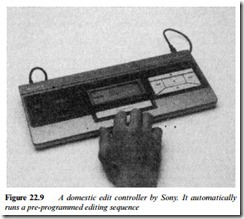VIDEORECORDER EDIT CONTROLLERS
In post-production editing of videotaped material the operator has two roles – an aesthetic and a ‘mechanical’ one. To help with the latter, professional editing studios have long had available automatic editing systems, in which the master copy is assembled in a recorder whose record-pause function is automatically control- led by a microcomputer-based auto-editor. It works from a software program in which the edit-in and edit-out points of the visual and sound material from one or more ‘source’ playback machines are stored. The reference points for these come from cue codes or true frame codes recorded on longitudinal or helical video tape tracks.
These techniques are now available in domestic hardware for ‘home-movie’ enthusiasts. These less sophisticated (but still microcomputer-controlled) auto-editors require access to the pause control of the assembly recorder and the control input jacks of the source machine(s). The simpler types operate by counting field pulses from some chosen ‘start’ reference point in each source tape. More precise editing, down to single-frame accuracy, can be achieved in a domestic situation by the use of timecoding, typically built into the more expensive camcorders. For VHS-based formats the system is called VITC (Vertical Interval Time Code) and consists of teletext-type data recorded in the field blanking interval of the video signal on tape. For Video 8-based formats RCTC (Rewritable Consumer Time Code) is used, in which the timecode is written onto tape separate from the video signal itself, in an extension of each tape track at the beginning of head-scan, see Fig. 22.8. In both cases one code is recorded per TV field, containing data for programme hours, minutes, seconds and frames: this can be used to establish precise in- and out-edit points, stored as described above in an EDL – Edit Decision List. From this list both source and destination decks can be manipulated (the former for play, forward, rewind, and the latter for record and pause) to assemble a master tape from the raw footage of one or more camcorder tapes. Auto-editors come in stand-alone (Fig.
22.9) and computer-based forms, the latter consisting of software and hardware interfaces/cards for use with ordinary home PCs.
The composition of a master recording direct from another tape as described above is called linear or on-line editing. An alternative method is non-linear/off-line editing, in which the wanted programme segments are stored on the hard disc(s) of a home computer using MPEG data-compression technology similar to that described in Chapter 12. As with the DVC system covered in Chapter 19 the compression ratio is not so great as for broadcast DTV systems, and much computing power and hard disc space is required for this type of picture storage and manipulation. Some
DVC-format camcorders (see Chapter 19) have IEE1394 (‘Firewire’) interfaces, by which the signal data can be passed between cameras, decks, computers, printers etc. without being converted to analogue form.

